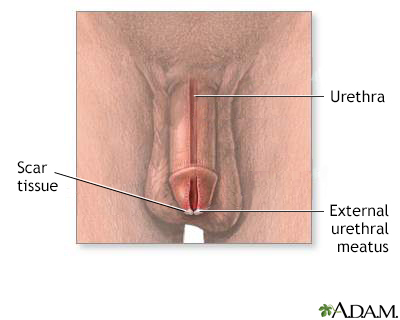Meatal stenosis
Urethral meatal stenosis
Meatal stenosis is a narrowing of the opening of the urethra, the tube through which urine leaves the body.
Images



I Would Like to Learn About:
Causes
Meatal stenosis can affect both males and females. It is more common in males.
In males, it is often caused by swelling and irritation (inflammation). In most cases, this problem occurs in newborns after circumcision. Abnormal scar tissue can grow across the opening of the urethra, causing it to narrow. The problem may not be detected until the child is toilet trained.
In adult men, the condition can result from surgery on the urethra, ongoing use of an indwelling catheter, or a procedure to treat an enlarged prostate gland (BPH).
In females, this condition is present at birth (congenital). Less commonly, meatal stenosis may also affect adult women.
Risks include:
- Having many endoscopic procedures (cystoscopy)
- Severe, long-term atrophic vaginitis
Symptoms
Symptoms include:
- Abnormal strength and direction of urine stream
- Bed wetting
- Bleeding (hematuria) at end of urination
- Discomfort with urination or straining with urination
- Incontinence (day or night)
- Visible narrowing of the urethral opening in boys
Exams and Tests
In men and boys, a history and physical exam are enough to make the diagnosis.
In girls, a voiding cystourethrogram may be done. The narrowing may also be found during a physical exam or when a health care provider tries to place a Foley catheter.
Other tests may include:
- Kidney and bladder ultrasound
- Urine analysis
- Urine culture
Treatment
In females, meatal stenosis is most often treated in the provider's office. This is done using local anesthesia to numb the area. Then the opening of the urethra is widened (dilated) with special instruments.
In boys, a minor outpatient surgery called meatoplasty is the treatment of choice. Dilation of the meatus may also be appropriate in some cases.
Outlook (Prognosis)
Most people will urinate normally after treatment.
Possible Complications
Complications may include:
- Abnormal urine stream
- Blood in the urine
- Frequent urination
- Painful urination
- Urinary incontinence
- Urinary tract infections
- Damage to bladder or kidney function in severe cases
When to Contact a Medical Professional
Contact your provider if your child has symptoms of this disorder.
Prevention
If your baby boy has recently been circumcised, try to keep the diaper clean and dry. Avoid exposing the newly circumcised penis to any irritants. They may cause inflammation and narrowing of the opening.
References
Chaudhry R, Cannon GM. Urologic disorders. In: Zitelli BJ, McIntire SC, Nowalk AJ, Garrison J, eds. Zitelli and Davis’ Atlas of Pediatric Physical Diagnosis. 8th ed. Philadelphia, PA: Elsevier; 2023:chap 15.
Elder JS. Anomalies of the penis and urethra. In: Kliegman RM, St. Geme JW, Blum NJ, Shah SS, Tasker RC, Wilson KM, eds. Nelson Textbook of Pediatrics. 21st ed. Philadelphia, PA: Elsevier; 2020:chap 559.
Marien T, Kadihasanoglu M, Miller NL. Complications of endoscopic procedures for benign prostatic hyperplasia. In: Taneja SS, Shah O, eds. Complications of Urologic Surgery. 5th ed. Philadelphia, PA: Elsevier; 2018:chap 26.
Virasoro R, Jordan GH, McCammon KA. Surgery for benign disorders of the penis and urethra. In: Partin AW, Domochowski RR, Kavoussi LR, Peters CA, eds. Campbell-Walsh-Wein Urology. 12th ed. Philadelphia, PA: Elsevier; 2021:chap 82.
BACK TO TOPReview Date: 1/1/2023
Reviewed By: Kelly L. Stratton, MD, FACS, Associate Professor, Department of Urology, University of Oklahoma Health Sciences Center, Oklahoma City, OK. Also reviewed by David C. Dugdale, MD, Medical Director, Brenda Conaway, Editorial Director, and the A.D.A.M. Editorial team.

Health Content Provider
06/01/2025
|
A.D.A.M., Inc. is accredited by URAC, for Health Content Provider (www.urac.org). URAC's accreditation program is an independent audit to verify that A.D.A.M. follows rigorous standards of quality and accountability. A.D.A.M. is among the first to achieve this important distinction for online health information and services. Learn more about A.D.A.M.'s editorial policy, editorial process and privacy policy. A.D.A.M. is also a founding member of Hi-Ethics. This site complied with the HONcode standard for trustworthy health information from 1995 to 2022, after which HON (Health On the Net, a not-for-profit organization that promoted transparent and reliable health information online) was discontinued. |
The information provided herein should not be used during any medical emergency or for the diagnosis or treatment of any medical condition. A licensed medical professional should be consulted for diagnosis and treatment of any and all medical conditions. Links to other sites are provided for information only -- they do not constitute endorsements of those other sites. © 1997- 2024 A.D.A.M., a business unit of Ebix, Inc. Any duplication or distribution of the information contained herein is strictly prohibited.
